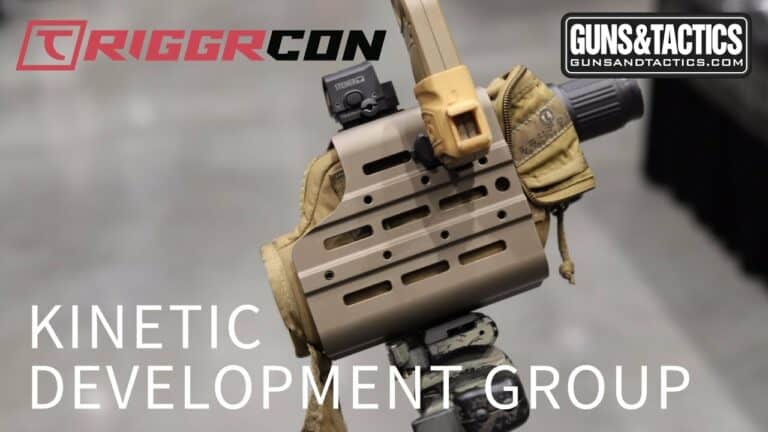SureFire SOCOM-4 Series—A New Fighting Suppressor
Fountain Valley, CA—SureFire, LLC, manufacturer of the world’s finest—and most innovative—illumination tools and…
Fountain Valley, CA—SureFire, LLC, manufacturer of the world’s finest—and most innovative—illumination tools and…
Shinenyx—creators of a cutting-edge fusion of digital night vision and thermal imaging technology—has…
German Precision Optics’ Passion APO is a high-performance compact spotting scope designed and…
The Mod-Navy Qual I’ve been doing this qual (or drill, or whatever the current nom…
• Built for road trips and off-road use• Manual transmission equipped• Wrapped in MultiCam Arctic…
I designed the Button Man to give shooters a low-round-count, low-light-engagement drill that involved both…
[dcs_img_right
framed=”black” w=”250″ h=”80″]
http://gunsandtactics.wpengine.com/wp-content/uploads/2012/05/rheinmetall_logo.jpg
[/dcs_img_right]
We’ve already taken a look at the Wiesel and Marder armored vehicle families built by German defense giant Rheinmetall, which will be exhibiting at this year’s Eurosatory defense exposition in Paris June 11-15. As mentioned in Part 1, Rheinmetall offers a long list of defense products, from vehicles to air defense systems to ammunition to mine clearing, nuclear-biological-chemical (NBC) reconnaissance, and cargo handling. But we’ve kept our focus on some of its sexier offerings, looking at four of its tracked vehicle families. Here we’ll consider two of its premiere products: the Puma infantry fighting vehicle and the Leopard 2 main battle tank.
Germany’s original postwar tank, the Leopard 1, entered service in 1963. Over 6,000 were produced, and in addition to service with the Bundeswehr it was exported to nine NATO members and allied countries. Its successor, the Leopard 2, entered service in 1979. So far about 3,200 have been produced, and the tank is in service with 15 countries besides Germany, including some as far away as Singapore and Chile.
The Leopard 2 has evolved through a number of variants. The latest, the Leopard 2 A7+, was introduced in June 2010. It adds a modular protection kit along with improvements in sustainability and mobility to the already-respectable capabilities of the A6, and Saudi Arabia was approved by the German government in July 2011 to purchase 200 of these newest Leopard 2s.
The tank is built around the Rheinmetall 120mm L55 main gun, introduced on the A6 variant to replace the shorter L44 model previously used. The longer barrel is capable of achieving higher muzzle velocities, particularly important for the LKE 2 DM53 kinetic energy penetrator which can reach velocities of 1,750 meters per second and ranges of 5,000 meters.
While the tank commander has an independent sight, the fire control system allows the gunner and commander to share the same image if needed. The gun is fully stabilized for firing on the move, and the gunner has a dual magnification optical sight, Zeiss Optronik thermal sight, and an integrated laser rangefinder capable of delivering three range readings in four seconds.
In 2004, a new mine protection system was developed for the Leopard 2 which not only enables the vehicle to survive an under-hull anti-tank mine detonation, but also to do so without injury to the crew. This add-on kit has been widely retrofitted to Leopard 2s already in service.
The Leopard 2 has been produced in several additional variants for export clients. These include the 2E (a more heavily armored version of the A6) for Spain, the 2(S) (with passive armor and an improved command and control system) for Sweden, and the A4M CAN and A6M CAN (with upgraded mine defenses and slat armor) for Canada, which are currently serving with Canadian forces in Afghanistan.
Of course, every good main battle tank needs infantry support, which is where the Puma infantry fighting vehicle (IFV) enters the picture. Replacing the venerable Marder (profiled in Part 1), the Puma prototype was delivered in May 2006. Five preproduction vehicles were delivered to the Bundeswehr in 2007, beginning trials in early 2008 and successfully completing them in March 2009. The initial contract is for 405 units.
The Puma’s primary armament is a Mauser Mk. 30-2 30mm cannon, capable of 700 rounds per minute out to 3,000 meters. Available ammunition includes a kinetic energy penetrator (armor-piercing, fin-stabilized discarding sabot) and a frangible armor-piercing incendiary discarding sabot with tracer (FAPIDS-T) round. The Bundeswehr is also testing an airburst munition for possible use with the Puma’s main gun.
Like the U.S. Bradley IFV, the Puma also has an anti-tank missile launcher to engage main battle tanks that are immune to its main gun. The Puma will use the Spike-LR, which unlike the wire-guided TOW and Milan is a fire-and-forget weapon—a big plus for the vehicle’s survivability.
In addition to armor capable of defeating 14.5mm projectiles at any point on the vehicle, 30mm kinetic energy penetrators on the front and flanks, and shaped-charge rounds on the front. The Puma can withstand mines equivalent to 10 kilograms of TNT and explosively-formed penetrators (EFPs). It will also employ an anti-tank missile defense system capable of engaging up to four threats simultaneously.
Rheinmetall will be exhibiting at outdoor area Pe6b D210 for Eurosatory 2012.
Guns & Tactics is an online media outlet that focuses on the firearms community, not just firearms and gear but also quality training, technical break downs and enlightening presentations.

TriggrCon 2017: Chris has a chat with Nate Murr about the new Optics Hub. Kinetic Development Group TriggrCon Find all of our TRIGGRCON coverage here and on our…
[dcs_img_right framed=”black” w=”165″ h=”115″] http://gunsandtactics.wpengine.com/wp-content/uploads/2012/03/konuslogo.jpg [/dcs_img_right] Konus Optical & Sports System joins the social networking community with the launch of its Facebook page where fans will be able…
[dcs_img_center desc=”Visit MPA SHOT Show 2013 at Booth 2716″ framed=”no” w=”600″ h=”219″] http://gunsandtactics.wpengine.com/wp-content/uploads/2012/12/mpar-600.png [/dcs_img_center] [dcs_post_top] [dcs_fancy_header color=”#000000″ fweight=”bold”]MasterPiece Arms is pleased to announce the new MPAR 556 Rifle,…
[dcs_img_center framed=”no” w=”600″ h=”448″] http://gunsandtactics.wpengine.com/wp-content/uploads/2013/01/mac-pistol.png [/dcs_img_center] [dcs_post_top] [dcs_fancy_header color=”#000000″ fweight=”bold”]Eagle Imports, the exclusive distributor of the Metro Arms family of products, brings the powerful and compact MAC 1911…

Do you get tired of gas in your face when shooting suppressed? It’s ok to admit it happens but we have a solution that 4 out of 5…
Looking for a weekend warrior challenge to test your basic tactical skills? Well my friends, ITS Tactical just might have the course you’ve been looking for. Although more…
© 2025 UN12 Magazine
© 2025 UN12 Magazine
Wait! Don’t forget to